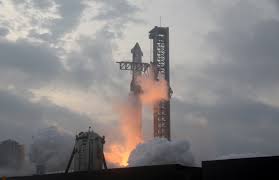Starship Soars Again: SpaceX’s 6th Successful Launch Marks Major Progress

Starship Soars Again: SpaceX’s 6th Successful Launch Marks Major Progress
Introduction: In a historic milestone for space exploration, SpaceX has successfully completed its 6th launch of the Starship rocket, bringing humanity’s vision of interplanetary travel and Mars colonization one step closer to reality. The successful launch marks not only a major achievement for Elon Musk’s private space company but also signals significant progress in the development of Starship—a spacecraft designed to revolutionize space travel. With its ability to carry both crew and cargo to distant destinations, including the Moon and Mars, Starship represents a leap forward in space exploration technology. This achievement is especially significant as it highlights SpaceX’s growing reliability in the space industry, further cementing its position as a leader in the field. In this article, we delve into the importance of the 6th successful Starship launch, the capabilities it demonstrates, and the broader implications for future missions to the Moon, Mars, and beyond.
The Significance of SpaceX’s 6th Starship Launch: SpaceX’s 6th successful launch of Starship is a landmark achievement for both the company and the space industry as a whole. Each successful flight brings SpaceX closer to its ambitious goals of reducing the cost of space travel, enabling deep space exploration, and eventually making interplanetary travel a reality. Starship is designed to be the most powerful spacecraft ever built, capable of carrying large numbers of passengers and payloads into space, which could dramatically transform not only the way we approach space exploration but also how we live on Earth.
For SpaceX, the consistent success of Starship launches marks a significant step in building confidence with clients, investors, and future mission partners. SpaceX has already disrupted the space industry with its Falcon 9 rocket’s reusability, but Starship takes that a step further with its massive payload capacity, its ability to launch and land multiple times, and its goal of eventually enabling long-duration missions to destinations like Mars. Each successful launch is a vote of confidence in the technology that will define the next phase of space exploration.
Additionally, Starship’s successful flights serve as a testbed for technologies that could be pivotal in the future of space travel, such as reusable rocket systems, advanced propulsion methods, and autonomous navigation. With each mission, SpaceX gathers critical data and refines its systems to ensure that Starship will be capable of sustaining long-duration space missions, including manned missions to Mars, while maintaining safety, reliability, and affordability.
The Technology Behind Starship’s Success: Starship is a revolutionary spacecraft in many ways. Unlike traditional rockets, it is designed to be fully reusable, which significantly reduces the cost of space travel. This reusability is achieved through the Starship’s two-stage design: the first stage, Super Heavy, provides the initial thrust needed to propel the spacecraft into orbit, while the second stage, the Starship spacecraft itself, is capable of carrying large payloads or crews to their intended destinations.
The key to Starship’s reusability is its ability to land vertically after each flight, a design feature that SpaceX has successfully refined with its Falcon rockets. This ability allows for rapid reuse of both the booster and the spacecraft itself, a major breakthrough that drastically reduces launch costs. Starship also features a heat shield designed to withstand the intense temperatures of re-entry, allowing it to return to Earth safely and repeatedly.
Another key technological achievement of Starship is its Raptor engines, which use methane as fuel. The engines are designed to be more efficient and powerful than conventional rocket engines, making Starship capable of reaching higher altitudes and carrying much larger payloads. SpaceX has been testing the Raptor engines extensively to ensure they can perform reliably during multiple launches and landings.
With the 6th successful launch, SpaceX has demonstrated that Starship’s systems are functioning as intended and are ready to be used for more ambitious missions. The technology behind Starship is setting the stage for future missions to the Moon, Mars, and beyond, and each successful flight provides invaluable data to refine the rocket’s capabilities.
Implications for Mars and Moon Missions: The success of Starship is pivotal to achieving Elon Musk’s long-term goal of establishing a permanent human presence on Mars. Musk has often stated that one of the core objectives of SpaceX is to make life multiplanetary, and Starship is the vehicle that will enable that vision. As humanity faces the challenge of protecting Earth from existential threats, including climate change and resource depletion, Musk believes that colonizing Mars will serve as a backup plan for humanity’s survival.
The Starship spacecraft’s massive size, payload capacity, and reusability make it the ideal vehicle for transporting large groups of people, as well as essential equipment, to Mars. The rocket is designed to carry up to 100 passengers at a time, along with the necessary supplies for long-duration missions. For a mission to Mars, this could include everything from life support systems to habitats, food production facilities, and other critical infrastructure for sustaining human life on the planet.
Starship is also a key component of NASA’s Artemis program, which aims to return humans to the Moon by the mid-2020s. NASA has selected SpaceX’s Starship as the lander that will transport astronauts from lunar orbit to the Moon’s surface, demonstrating the spacecraft’s versatility. With its ability to land on the Moon and return to orbit, Starship could be a vital tool in establishing a sustainable human presence on the lunar surface, paving the way for future exploration of Mars and other celestial bodies.
The continued success of Starship’s launches will also allow SpaceX to further test the systems required for long-duration space missions. From radiation shielding to life support systems, these tests will be critical for ensuring that Starship is ready to support human missions to Mars, where astronauts will face challenges related to isolation, resource management, and environmental hazards.
The Future of Space Exploration and SpaceX’s Leadership: As SpaceX continues to refine and perfect the Starship, its leadership in the space exploration sector is becoming increasingly undeniable. The company has already demonstrated its ability to perform routine launches with its Falcon 9 rocket and has successfully delivered astronauts to the International Space Station as part of NASA’s Commercial Crew Program. However, Starship takes SpaceX’s capabilities to an entirely new level, opening up new frontiers in space exploration, tourism, and interplanetary colonization.
The continued success of Starship will position SpaceX at the forefront of the emerging space economy, which is expected to grow exponentially over the next few decades. From satellite launches to space tourism, resource mining, and research missions, the possibilities are limitless. As more companies and nations invest in space exploration, SpaceX’s leadership in reusable rocket technology and interplanetary travel will play a central role in shaping the future of the space industry.
The 6th Starship launch is not just a testament to SpaceX’s success—it is a powerful reminder of what can be achieved when ambitious goals are combined with innovation and determination. Each launch brings us closer to a future where humanity is no longer confined to Earth, and where space is no longer the realm of governments alone but open to all who have the vision and drive to reach it.
Conclusion: SpaceX’s 6th successful launch of Starship is a monumental achievement, marking a pivotal moment in the quest for interplanetary exploration and Mars colonization. With its advanced technology, reusability, and massive payload capacity, Starship is poised to revolutionize space travel and open the door to a future where humans can live and thrive beyond Earth. While there are still many challenges ahead, the success of Starship’s launches brings us one step closer to making Mars and other celestial destinations a reality. SpaceX’s leadership in space exploration is shaping the future of humanity, and the successful flight of Starship is a powerful symbol of what is possible when vision and technology come together. The sky is no longer the limit—Starship is charting the path to the stars.









